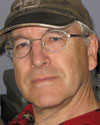 Richard I. Macphail |
2009 Rip Rapp Archaeological Geology Award
Presented to Richard I. Macphail
Citation by Paul Goldberg
Someone came up to me at Micromorphology Working Group meeting in London in 1981 wanting to show me some thin sections about ancient agriculture in the UK, and I said, “sure.” That was the beginning of a friendship that has lasted almost 30 years. Since that time, Rich has had a lengthy and productive career as a geoarchaeologist, contributing his knowledge of soils and landscapes in order to obtain a better, more complete and accurate understanding of past human occupations and activities.
Rich has been one of the principal promoters of soil microchemical (e.g., microprobe, magnetic susceptibility) and micromorphological techniques applied to archaeological issues and topics. The spectrum of topics is broad and include: palaeoagriculture and early pastoralism in Europe and the Middle East, Palaeolithic sites and their environmental settings (Boxgrove; Gorham’s Cave), experimental archaeology (e.g., Butser Farm, Overton Down, and Wareham), human-induced landscape changes, urban archaeology (e.g., Dark Earth and early Medieval occupation and floor deposits), and the analysis of human materials (e.g., lime plaster, mortar, and other building materials). He has published numerous articles on soils, soil micromorphology, and archaeological sediments, and has co-authored texts in micromorphology and geoarchaeology; he also served as author and editor of a collection of papers that focuses on archaeological soils and sediments.
Rich has also served the academic community as an active member of the editorial board of the journal, Geoarchaeology, and has done more than his share of vetting manuscripts, always a team player. In addition, he has given numerous intensive short courses in Archaeological Soil Micromorphology for international students and researchers, and is an active participant in Soil Micromorphology Workshops, such as the one held this past summer in Italy. He has been a visiting scholar in France, Belgium, and Italy, where he taught geoarchaeology courses that emphasized the significance of soils in archaeological research. Lastly, Rich’s field areas span the globe, where he has carried out research on sites in the UK, the United States, Gibraltar, Korea, Djibouti, Sweden, Germany, Hungary, Israel, Italy, and China; the sites are too numerous to list.
In sum, Richard is intensely dedicated to the field of Geoarchaeology. He has not only produced research of his own but has been a beacon of information and help for students and colleagues from all over the globe who have sought out his expertise and knowledge. He has contributed immensely to the field of geoarchaeology, and has raised the bar about how we go about interpreting archaeological sites. He is well deserving of the Rip Rapp Award, and I am honored to be able to be his citationist.
 2009 George (Rip) Rapp Archaeological Geology Award — Response by Richard I. Macphail
2009 George (Rip) Rapp Archaeological Geology Award — Response by Richard I. Macphail
It was a complete, but most welcome surprise to become the recipient of the 2009 Geological Society of America’s Rip Rapp Award for Archaeological Geology. As a Brit I feel even more gratified by this honour, and hopefully this reflects well on the standard of geoarchaeology both in the UK and Europe as a whole. Nevertheless, I imagine that part of this recognition results from my close collaboration with Paul Goldberg, the journal Geoarchaeology (at which he was an editor for so long), and Boston University where I am an Associate Research Fellow in the Department of Archaeology. In fact over the last decade, Boston has become something of a second home and laboratory!
Over the years, Paul and I have worked together on a number of North American sites, and these has given me an extra dimension to my understanding of geoarchaeology especially in hunter and gather site investigations. Importantly, I think that I have successfully transferred some of this improved understanding to Europe.
I am also indebted to my other chief co-worker, Marie-Agnès Courty of the French CNRS, and all those experts who helped train me from my earliest studies in the 1970s (including the late Peter Bullock and John CC Romans). Equally, I also wish to acknowledge the contribution of all members of the Archaeological Soil Micromorphology Working Group who have helped develop and broaden this field within geoarchaeology since 1990. Just as importantly, I thank the many academic bodies (British Academy, English Heritage, The Leverhulme Trust) and commercial companies (Geo-Marine Inc, Museum of London Archaeology, Oxford Archaeology, Statistical Research Inc, Wessex Archaeology — to name but a few) for funding. It is clear that they truly value the contribution of microstratigraphic investigations to archaeology. It is also important to note that soil micromorphological results have been greatly enhanced by the contributions of archaeological colleagues (too numerous to list), palaeoenvironmentalists (Mike Allen, Jill Cruise and Pat Wiltshire) and soil chemists (John Crowther and Johan Linderholm). Lastly, none of these studies would have been possible without the scientific base provided by the Institute of Archaeology, University College London since 1978. Over the last decade for example, amazing support has been received from the following (again to name but a few!): Sandra Bond, Barbara Brown, Kevin Reeves, Thilo Rehren, Arlene Rosen, Stephen Shennan (director of the IoA) and the late Peter Ucko (retired director of the IoA).
Once again, I’d like to thank Paul Goldberg for being my citationist for this award, and I am extremely grateful to the Geological Society of America and committee members such as Ralph Mandel, for honouring me and my discipline in this way.
